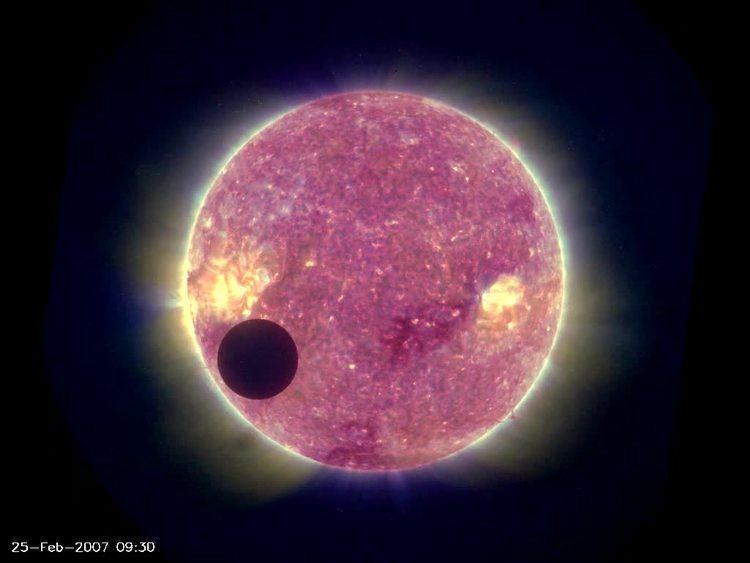 | ||
In astronomy, a transit or astronomical transit is the phenomenon of at least one celestial body appearing to move across the face of another celestial body, hiding a small part of it, as seen by an observer at some particular vantage point.
Contents
Definition
The word "transit" refers to cases where the nearer object appears considerably smaller than the more distant object. Cases where the nearer object appears larger and completely hides the more distant object are known as occultations.
One example of a transit involves the motion of a planet between a terrestrial observer and the Sun. This can happen only with inferior planets, namely Mercury and Venus (see transit of Mercury and transit of Venus). However, as seen from outer planets such as Mars, the Earth itself transits the Sun on occasion.
The term can also be used to describe the motion of a satellite across its parent planet, for instance one of the Galilean satellites (Io, Europa, Ganymede, Callisto) across Jupiter, as seen from Earth.
A transit requires three bodies to be lined up in a single line. More rare are cases where four bodies are lined up. The one closest to the present occurred on 27 June 1586, when Mercury transited the Sun as seen from Venus at the same time as a transit of Mercury from Saturn and a transit of Venus from Saturn.
In recent years the discovery of extrasolar planets has excited interest in the possibility of detecting their transits across their own stellar primaries. HD 209458b is the first such transiting planet to be discovered.
Mutual planetary transits
In rare cases, one planet can pass in front of another. If the nearer planet appears smaller than the more distant one, the event is called a mutual planetary transit.
Contacts
During a transit there are four "contacts", when the circumference of the small circle (small body disk) touches the circumference of the large circle (large body disk) at a single point. Historically, measuring the precise time of each point of contact was one of the most accurate ways to determine the positions of astronomical bodies. The contacts happen in the following order:
A fifth named point is that of greatest transit, when the apparent centers of the two bodies are nearest to each other, halfway through the transit.
Notable observations
No missions were planned to coincide with the transit of Earth visible from Mars on 11 May 1984 and the Viking missions had been terminated a year previously. Consequently, the next opportunity to observe such an alignment will be in 2084.
On December 21, 2012, the Cassini–Huygens probe, in orbit around Saturn, observed the planet Venus transiting the Sun.
On 3 June 2014, the Mars rover Curiosity observed the planet Mercury transiting the Sun, marking the first time a planetary transit has been observed from a celestial body besides Earth.
